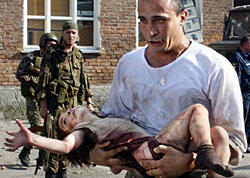Cult of Death or Heart of Man
 David Brooks, in a NY Times Op-Ed piece after the Beslen school massacre, in 2016, said the following about the Muslim terrorists:
David Brooks, in a NY Times Op-Ed piece after the Beslen school massacre, in 2016, said the following about the Muslim terrorists:
We should be used to this pathological mass movement by now. We should be able to talk about such things. Yet when you look at the Western reaction to the Beslan massacres, you see people quick to divert their attention away from the core horror of this act, as if to say: We don’t want to stare into this abyss. We don’t want to acknowledge those parts of human nature that were on display in Beslan. Something here, if thought about too deeply, undermines the categories we use to live our lives, undermines our faith in the essential goodness of human beings.It should come as no surprise to me — yet it still does — that people have any confidence remaining in idea of the “essential goodness of human beings.” Yet this is perhaps one of the most durable myths of our modern secular age. It underlies both public policy and private perception, and forms the basis of many failed government and social programs. If you have the stomach for it and the honesty to look objectively, even a brief glance at human history both ancient and modern reveals vastly more evidence of the depravity of man than his essential goodness. Consider briefly the following examples: the Inquisition, slavery, Ghengis Kahn, the Holocaust, the Bataan Death March, the Cambodian killing fields, Rwanda, Idi Amin, Columbine, Saddam’s rape rooms and shredders, suicide bombers on school buses and in pizza parlors, the rape of Nanking, the gulags, and Wounded Knee. And these are only the large historical events, easy to bring to mind. Left unmentioned but vastly outnumbering these are the countless murders, rapes, child molesters, serial killings, drug dealing, and any number of other smaller – but still profoundly evil – events which now barely if ever make the news.
I am not a misanthrope, and am fully aware of the potential for man to achieve great goodness and nobility. From the selfless volunteer at an inner city school to Mother Theresa, countless examples of such goodness and nobility exist, often hidden and far less noticed than deeds of evil. The issue is about the natural inclination, the deep inner nature of man – is it toward good, or rather toward evil? Your answer to this question profoundly affects your worldview.
By taking the position that man is essentially good, you are left with the problem of understanding inexplicable evil, such as torturing school children and shooting them in the back as they flee, as occurred at Beslan. In evil of lesser scope, psychology and social theory are often recruited for this task: the child molester or rapist was abused as a child; inner city crime is a result of racism; the root of terrorism is poverty, injustice, and the oppression of the Palestinians by the Jews. Even there the answers fall short. But could any such combination of social liabilities give rise to such extreme evil, as seen at Beslan or Auschwitz – particularly in beings whose natural bent is toward goodness?
The Judeo-Christian viewpoint on man’s essential nature is that man is fallen: created by a good God to be by nature good, but given free will either to submit to the good or to choose evil. Having rejected the good for personal autonomy independent of God, the natural gravity of the soul is away from God, not toward Him. In God is an unspeakable and unimaginable goodness; in His rejection is the potential for equally unimaginable evil. The Judeo-Christian solution is redemption, not psychology; inner transformation, not social programs.
To resist evil, you must know the face of evil, and recognize the face of good. The secularist denies the existence of God (or counts Him or it irrelevant), and therefore all goodness must have its source within man. The religious liberal believes God is good, but impotent, and therefore man is responsible to do the heavy lifting of all good works. The traditional Christian or Jew understands that man, created by God with enormous potential for good, but corrupted by failure to submit to God and therefore by nature far more prone to evil than good.
Religious affiliation is an unreliable indicator of good or evil behavior. The combination of evil motives with the compulsion of legalistic religion is a potent and dangerous mix, where men pursue their evil goals under the lash of and laboring for an angry god of their own making.
Man’s tendency to evil can be restrained, either by force of law, by force of arms, or ideally by inner transformation, repentence and submission to the power of humility and service. Wishful thinking and false assumptions about the goodness of man will prove woefully inadequate for the encroaching and fearsome evil of our current century.